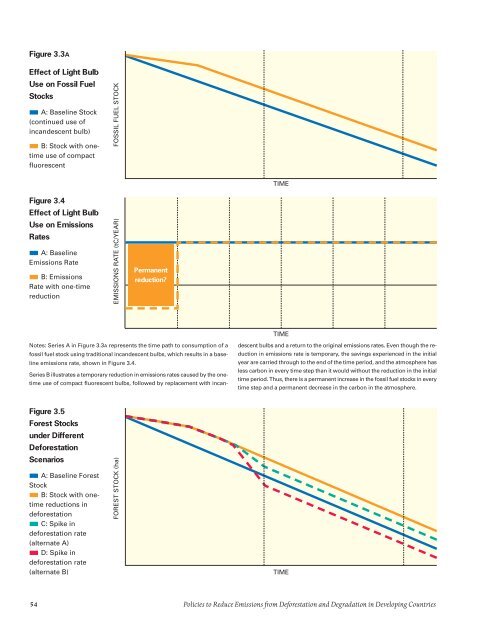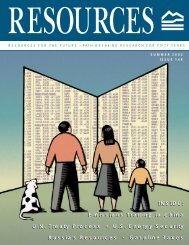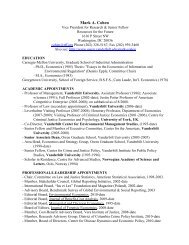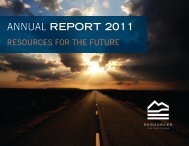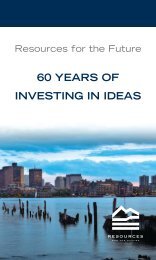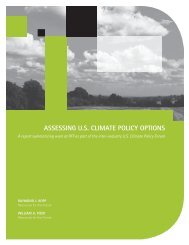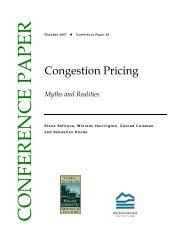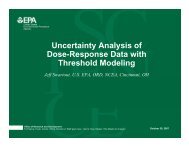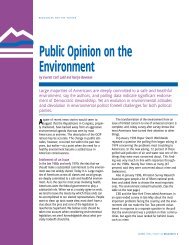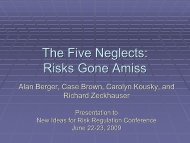Policies to Reduce Emissions from Deforestation and Degradation ...
Policies to Reduce Emissions from Deforestation and Degradation ...
Policies to Reduce Emissions from Deforestation and Degradation ...
Create successful ePaper yourself
Turn your PDF publications into a flip-book with our unique Google optimized e-Paper software.
Figure 3.3A<br />
Effect of Light Bulb<br />
Use on Fossil Fuel<br />
S<strong>to</strong>cks<br />
ıı A: Baseline S<strong>to</strong>ck<br />
(continued use of<br />
inc<strong>and</strong>escent bulb)<br />
ıı B: S<strong>to</strong>ck with onetime<br />
use of compact<br />
fluorescent<br />
Figure 3.4<br />
Effect of Light Bulb<br />
Use on <strong>Emissions</strong><br />
Rates<br />
ıı A: Baseline<br />
<strong>Emissions</strong> Rate<br />
ıı B: <strong>Emissions</strong><br />
Rate with one-time<br />
reduction<br />
Notes: Series A in Figure 3.3A represents the time path <strong>to</strong> consumption of a<br />
fossil fuel s<strong>to</strong>ck using traditional inc<strong>and</strong>escent bulbs, which results in a baseline<br />
emissions rate, shown in Figure 3.4.<br />
Series B illustrates a temporary reduction in emissions rates caused by the onetime<br />
use of compact fluorescent bulbs, followed by replacement with incan-<br />
Figure 3.5<br />
Forest S<strong>to</strong>cks<br />
under Different<br />
<strong>Deforestation</strong><br />
Scenarios<br />
ıı A: Baseline Forest<br />
S<strong>to</strong>ck<br />
ıı B: S<strong>to</strong>ck with onetime<br />
reductions in<br />
deforestation<br />
ıı C: Spike in<br />
deforestation rate<br />
(alternate A)<br />
ıı D: Spike in<br />
deforestation rate<br />
(alternate B)<br />
FOSSIL FUEL STOCK<br />
EMISSIONS RATE (tC/YEAR)<br />
FOREST STOCK (ha)<br />
Permanent<br />
reduction?<br />
descent bulbs <strong>and</strong> a return <strong>to</strong> the original emissions rates. Even though the reduction<br />
in emissions rate is temporary, the savings experienced in the initial<br />
year are carried through <strong>to</strong> the end of the time period, <strong>and</strong> the atmosphere has<br />
less carbon in every time step than it would without the reduction in the initial<br />
time period. Thus, there is a permanent increase in the fossil fuel s<strong>to</strong>cks in every<br />
time step <strong>and</strong> a permanent decrease in the carbon in the atmosphere.<br />
54 <strong>Policies</strong> <strong>to</strong> <strong>Reduce</strong> <strong>Emissions</strong> <strong>from</strong> <strong>Deforestation</strong> <strong>and</strong> <strong>Degradation</strong> in Developing Countries<br />
TIME<br />
TIME<br />
TIME


